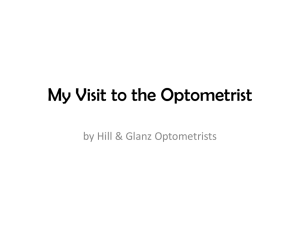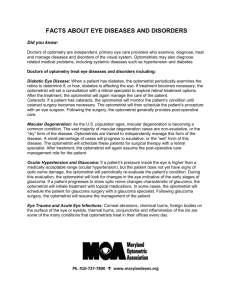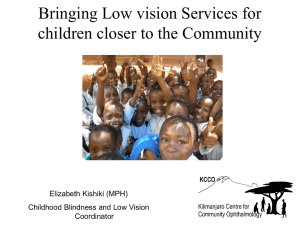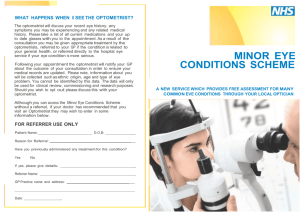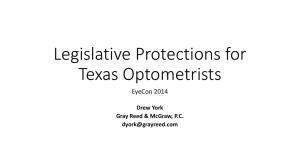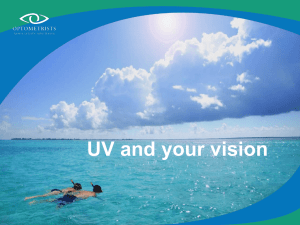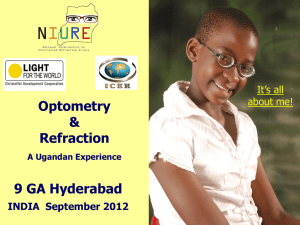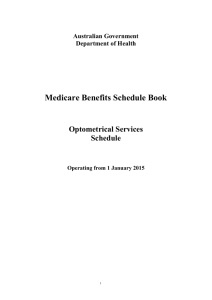What you should expect in an initial optometric consultation
advertisement
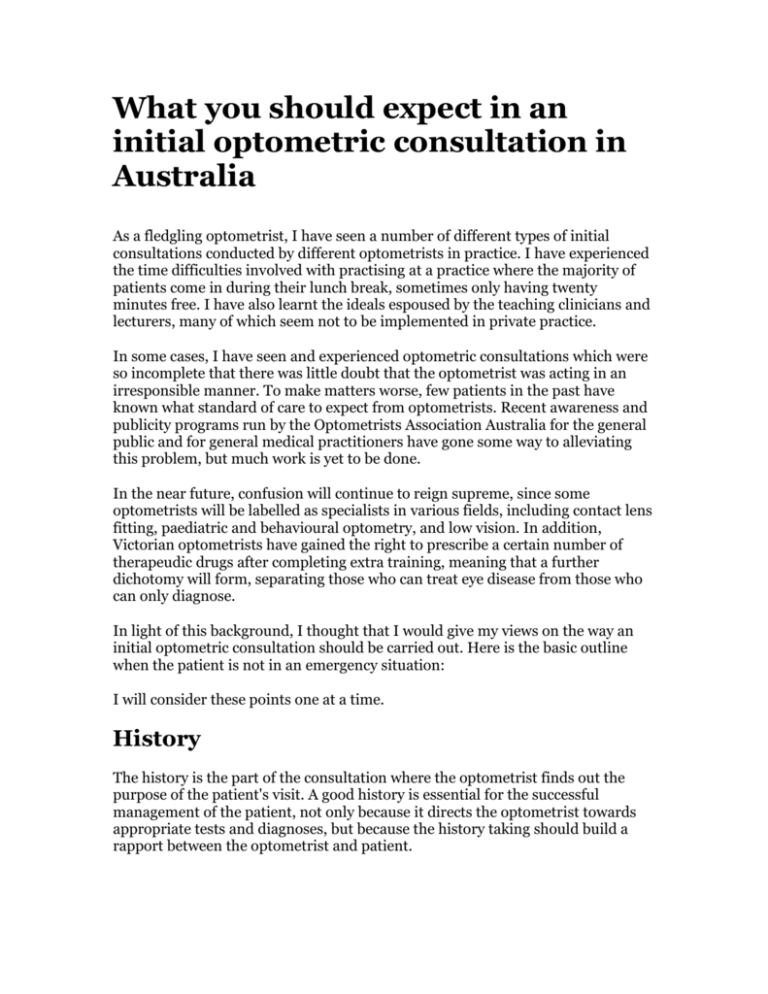
What you should expect in an initial optometric consultation in Australia As a fledgling optometrist, I have seen a number of different types of initial consultations conducted by different optometrists in practice. I have experienced the time difficulties involved with practising at a practice where the majority of patients come in during their lunch break, sometimes only having twenty minutes free. I have also learnt the ideals espoused by the teaching clinicians and lecturers, many of which seem not to be implemented in private practice. In some cases, I have seen and experienced optometric consultations which were so incomplete that there was little doubt that the optometrist was acting in an irresponsible manner. To make matters worse, few patients in the past have known what standard of care to expect from optometrists. Recent awareness and publicity programs run by the Optometrists Association Australia for the general public and for general medical practitioners have gone some way to alleviating this problem, but much work is yet to be done. In the near future, confusion will continue to reign supreme, since some optometrists will be labelled as specialists in various fields, including contact lens fitting, paediatric and behavioural optometry, and low vision. In addition, Victorian optometrists have gained the right to prescribe a certain number of therapeudic drugs after completing extra training, meaning that a further dichotomy will form, separating those who can treat eye disease from those who can only diagnose. In light of this background, I thought that I would give my views on the way an initial optometric consultation should be carried out. Here is the basic outline when the patient is not in an emergency situation: I will consider these points one at a time. History The history is the part of the consultation where the optometrist finds out the purpose of the patient's visit. A good history is essential for the successful management of the patient, not only because it directs the optometrist towards appropriate tests and diagnoses, but because the history taking should build a rapport between the optometrist and patient. The optometrist will normally divide the history into a number of sections on the patient's record card: Presenting complaint (PC) including a detailed summary of the main reasons for the visit, as well as answers to a barrage of stock questions. These questions should cover the topics of visual acuity and current forms of correction, blur, double vision, red/sore/itchy eyes, flashes and floaters, and presence of headaches. Other indicated questions to make symptoms more specific include duration, onset, severity, previous occurrence, remedies, and possible causation. Patient's ocular history (POH) detailing previous problems with the eyes or surrounding tissues. Typically, the optometrist will prompt by asking about operations, injuries, use of eye drops, and previous use of contact lenses. General health (GH) including all systemic conditions and associated medications. The optometrist will often prompt here by asking about allergies, headaches and blood pressure, as well as the last time the patient had a full checkup. This is slightly different for infants, since birth history may also be important. Family ocular history (FOH) covering ocular conditions found in relatives, especially siblings, parents, and others in the extended family related by blood. Important conditions to ask about include glaucoma, diabetes and cataract. If symptoms suggest some binocular vision problem, asking about lazy eye and turned eye is also useful. By the end of the history, the optometrist should have a good idea of any problems that exist, as well as possible diagnoses. He should also have a good idea of any expectations of the patient. To aid in these aims, it is advisable that the optometrist reiterate a summary of the presenting complaint to the patient in his own words, to check that there has not been misunderstanding. If the patient is in an emergency situation, immediate action should occur, and many other procedures that would normally occur will be disregarded. However, for legal reasons, some sort of assessment of monocular vision (with usual correction or pinhole) should always be attempted. Refraction The refraction is where the optometrist determines how well the patient currently sees, and whether this vision can be improved with refractive lenses. After checking vision, an optometrist will typically perform this in two stages: Objective refraction, which encompasses all those techniques allowing an optometrist to estimate refractive error without any need for patient feedback. This includes measuring up the power of previous glasses, retinoscopy, autorefraction and keratometry (or corneal topography) in strange astigmatic cases, or for the fitting of contact lenses. Subjective refraction, where the estimate is fine tuned by patient feedback. Generally, this is based on a series of pairwise comparisons, where the optometrist will ask the patient to point out the `better' of two views, or on the level of acuity through a certain set of lenses, normally gauged by reading a letter chart. At the end of the refraction, the optometrist should have a good idea about the refractive prescription of the patient. This may be modified by the results of various other tests, including those evaluating binocular vision or ocular health. Ocular motility and binocular status This series of tests is meant to evaluate the quality of eye movement, focussing, and the synkinesis between the two. There is a lot of difference in accepted levels of testing in this area. A full battery of tests on a young patient should include: Extent and ease of eye movement when following a target, as evaluated by the double-H pattern Near point of convergence (NPC) Cover test to determine strain on binocularity at distance and near, as well as picking any obvious heterotropia present Quality of fixation at distance and near Interpupillary distance measurement (pd) Dissociated horizontal and vertical deviation of the eyes (heterophoria/heterotropia at distance and near) Positive/Negative relative accommodation (PRA/NRA) and ease of refocussing through +/- 1D and 2D flippers Positive/Negative relative convergence (PRC/NRC) Stereopsis (depth perception) For infants who may not be able to cooperate enough to carry out these tests, there are other objective (though less reliable) tests to give estimates, like the numerous methods to establish the presence of a large heterotropia. It is not unusual for a number of these tests to be left out of a full initial consultation. Indeed, for people who have reached the age where they are experiencing presbyopia (loss of ability to focus correctly at close distances), many of these tests give us no useful information. However, I have noticed optometrists who perform a bare minimum of these tests on a regular basis, even when there is ample evidence of a major problem with binocularity, sometimes because they hold the opinion that binocular vision problems are too hard or intractable to deal with, once found. This attitude is understandable, since there is still much research going on in the area of binocular vision. However, these tests do allow optometrists familiar with the area to slow some cases of progressing myopia, reduce eyestrain and improve workplace ergonomics. Optometrists trained in sports vision also use these tests, along with others, to improve performance in sports that are visually demanding. Ocular health: External and anterior eye This will normally begin as soon as the patient meets the optometrist, since general observation can often be very helpful. On closer examination, the optometrist should examine not only the eyes, but the eyelids, eyelashes and general adnexa. Generally, a slit-lamp will be used to examine the anterior eye, including cornea, iris, lens, as well as the anterior chamber and anterior chamber angle. A direct ophthalmoscope used at 15–30 cm can be used to assess shape of opacity in the lens. Intraocular pressure is normally measured in patients over the age of 40, or those with another risk factor, including trauma, visual field loss, pain or family history. Ocular health: Posterior eye This can be done in a number of ways, all of which involve shining light into the eye, while simultaneously looking at the illuminated area with magnification. There are many different viewing systems, each of which gives a different perspective. There is much debate over the use of dilation drops to aid viewing. Though it is obvious that a large pupil gives better viewing (imagine looking through different sized keyholes), and thus better screening or diagnosis, the patient experiences increased glare and loss of ability to focus for a couple of hours. However, I consider that responsible health care requires optometrists to screen thoroughly for ocular health problems on the initial consultation (or soon after, at a subsequent consultation), which is difficult or impossible to do through an undilated pupil. Also, the effects of the dilating drops are not unbearable, especially with the use of sunglasses. Thus, the optometrist should check the optic disc, macula, blood vessels, as well as just generally checking the retina as far as possible out to the periphery. Other tests The last remaining tests tend to be those which evaluate some aspect of neurological function. These include assessment of colour vision and visual field. Colour vision is quickly and easily tested with Ishihara plates, and should be checked not only for legal reasons (like for a driving licence) but also in young children to guide them away from unsuitable occupations, especially those requiring very fine colour discrimination. The visual field is quickly and easily tested by confrontation, using finger counting or a red bottle top to give a gross estimate. There is a legal requirement that optometrists should assess visual field since a defective visual field can severly impair the ability to drive safely, for example. For more careful testing, like in the diagnosis and treatment of glaucoma, there is automated testing, run by a computer, which may take anywhere between 3 and 30 minutes, depending on the type and number of tests required. Management At the end of the consultation, the optometrist should summarise his findings, tell the patient about any problems, and then present options for treatment (and no treatment if pertinent). Note: An initial consultation differs from a referred consultation, since the referring optometrist should have supplied all basic pertinent details to the specialist to whom the patient is being referred. To avoid wasting the patient's time, procedures should not need to be repeated unnecessarily, and thus the specialist may be able to complete an abbreviated consultation, focussing mainly on the area of speciality.
